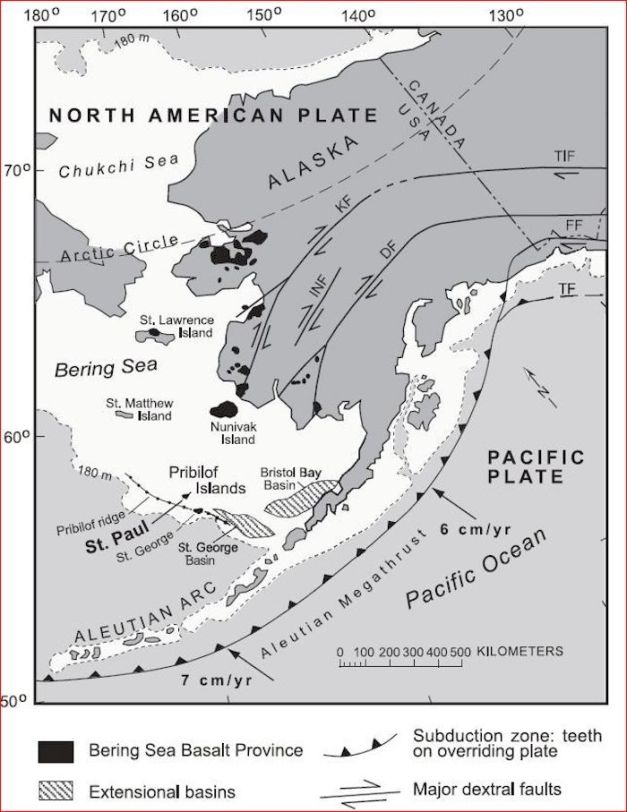
Bering Sea volcanic province. Screen capture from Winer, et al.
A few years ago, I wrote about three volcanic fields in the Seward Peninsula in far western Alaska. The post touched on the Bering Block as a possible tectonic player in the region. Why is it only a possible tectonic player? It is because the very existence of the block is in dispute. You can find the post here: https://volcanocafe.wordpress.com/2014/10/12/seward-peninsula-volcanic-fields/
The region includes much of western Alaska south of the Seward Peninsula. There are 15 volcanic fields and individual structures associated with the block.

Black Bluffs on Pribilof Islands. Looks to be entirely lava flows. http://serc.carleton.edu/research_education/nativelands/pribilofs/climate.html
The farthest inhabited location south is the Pribilof Islands. These are near the southern edge of the Alaskan continental shelf, some 320 km north of Unalaska (Aleutians), 320 km SW of Cape Newenham (Alaska coastline), and some 800 km SE Siberia. Total population of the islands is 572 as of 2010. They live on around 200 km of four islands, two of which are inhabited. Originally the economy centered on harvest of seals. Today, it is based on commercial and subsistence fishing for snow crab and halibut and support of various government activities.
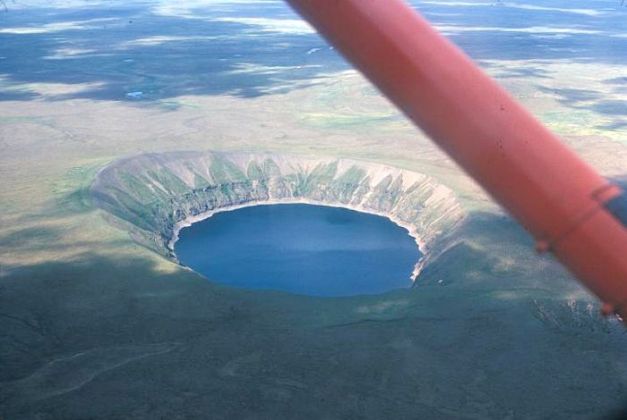
Nunivak Island maar circa 1970. Photo courtesy AVO. https://avo.alaska.edu/images/image.php?id=33393
Nunivak Island is the second largest of the Bering Sea islands. It is some 50 km offshore the Yukon – Kuskokwim River deltas. It covers 4,200 km2 and hosts a population of 201 (2000 census) who live in a single village on the north side of the island. Most of the natives depend on subsistence, commercial fishing, or industrial work on the mainland (mining). The island is part of the Yukon Delta National Wildlife Refuge.
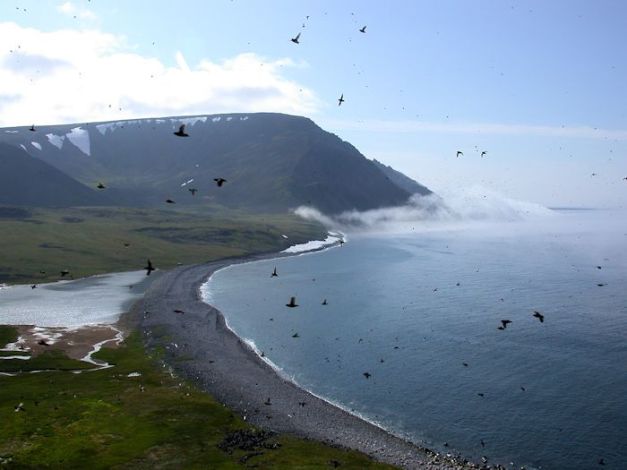
St. Lawrence Island is located just south of the Bering Strait. It is 58 km east of the Chukchi Peninsula in Russian Siberia, closer to Russia than the Alaskan mainland. It hosts 1,292 people on a 4,640 km2 island. The island was a forward base for US military during the Cold War. Economy for both villages is primarily subsistence hunting of whales, walrus, seals, and fish.
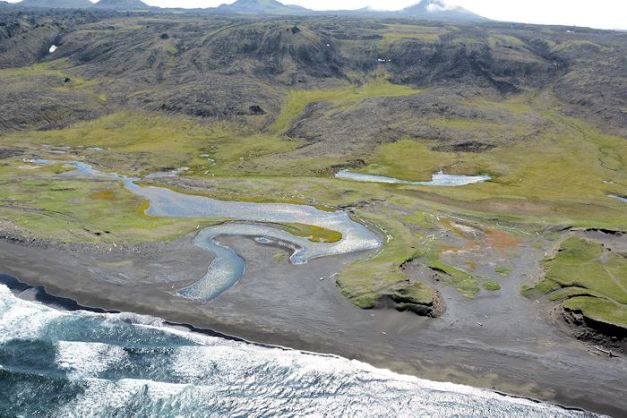
St. Lawrence Island, Alaska https://usresponserestoration.wordpress.com/2013/11/15/alaska-shorezone-mapping-over-46000-miles-of-coastal-habitat/bering-sea-st-lawrence-island-wetlands_shorezone/
While the region was relatively dicey during the Cold War, things have relaxed considerably since 1990, though it does see irregular visits from Russian jets just like the old days. There are not a lot of people living in the region. There is even less infrastructure. While the volcanic activity is not anywhere close to the explosiveness of Aleutian subduction driven volcanoes, several of the included fields have been quite productive in the not so distant past.

St. Lawrence Island, Alaska https://usresponserestoration.wordpress.com/2013/11/15/alaska-shorezone-mapping-over-46000-miles-of-coastal-habitat/bering-sea-st-lawrence-island-wetlands_shorezone/
Volcanoes
The entire region is called the Bering Sea Volcanic Province. Activity started some 5 – 6 Ma and continued to recent times. The activity seems to have shifted south and west over time. I have not seen anything to suggest this was due to hot spot, rifting, or simple plate (or block) motion over time. One paper notes that the chemistry of the basalts is similar to that of ocean island basalts which would be hot spot related. The problem with this is the widespread character of volcanism in the province.
Initial activity started in the Imuruk Lake volcanic field some 5 – 6 Ma. It produced around 110 km3 of magma, covering 1920 km2 over 845 ka. Eruptive products were basalts.

Teller Volcanic Field https://www.avo.alaska.edu/volcanoes/nonvolcanoes.php
The Teller volcanic field started around 3.5 MA and produced nearly 3 km3 of basalts covering 117 km2 over a 310 ka period. It has three volcanic necks and up to 30 vents.
Eruptions on St. George Island (Pribilofs) started 2.5 Ma eventually covering 95 km2 of the islands with 11 km3 of basalt 1050 ka. Activity on St. George lasted for over a million years. It was episodic producing three main periods of activity 2.5 Ma, 2.0 – 1.4 Ma, and 1.5 – 1.4 Ma.

St Paul Island volcanics. Photo courtesy AVO https://www.avo.alaska.edu/volcanoes/volcinfo.php?volcname=St.%20Paul%20Island
St. Paul Island (Pribilofs) erupted nearly 7 km3 over a 535 ka period starting around 420 ka. Eruptions continued until 130 ka and covered 115 km2 with various basalts. The young age of some of these lavas suggests that the island may still be active.

Kookooligit Mountains, Alaska https://volcano.si.edu/volcano.cfm?vn=314050
The Kookooligit Mountains on St. Lawrence Islands were prolific with nearly 100 km3 of basalts erupted over 980 ka starting 1.2 Ma. It consists of basalt cinder cones and lava flows combined to form a large shield volcano some 500 m high. Activity continued in this single complex for nearly 1 Ma.

Nunivak Island volcanics . Photo courtesy AVO circa 1970s. https://www.avo.alaska.edu/images/dbimages/1296864950_ak204.jpg
Eruptions on Nunivak Island and the St. Michael volcanic field began some 3 Ma, and produced around 59 and 119 km3 of basalts over a period of some 550 ka. Nunivak produced volcanic cones, broad lava flows, and maars.

St. Michael covers St. Michael and Stuart Islands, extending inland to the south. It consists of over 50 cones, craters, maars, and numerous lava flows. The oldest part of the field is on the mainland. Peak activity on St. Michael was from 180 – 120 ka. Local legends suggest continued activity into recent times, as recently as 2000 – 3000 years ago.
Given the remoteness, sparse population, lack of infrastructure, and arctic climate of the region, there is a considerable amount of lavas and cinder cones that have not been precisely dated at this time. Estimates of most recent activity are within the last few thousand years. Half of the volume of all the lavas in the province erupted in the last half million years.
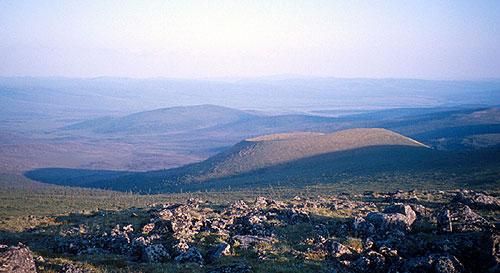
Prindle volcano, Alaska. Photo courtesy AVO. https://www.avo.alaska.edu/volcanoes/volcinfo.php?volcname=Prindle%20Volcano
There are several other volcanic fields and structures associated with the Bering Block that have not yet been studied or characterized. These include the Yukon Delta volcanic region, Flat Top Mountain volcano, Togiak volcanic field, Buzzard Creek maars, and the Prindle volcano.
There are some observations that suggest the magmas are evolving over time and that the eruptions are or will be getting more explosive as the magmas crystallize and fractionate over time.
The magmas are not thought to be related to either a plume or a back-arc basin subduction related to the Aleutians. Rather they are thought to be produced by hydrated upper mantle peridotite at relatively low temperatures that could reach the surface through local faults that served as weak points or conduits for the magmas.

Schematic of impact of Yakutat terrane on SC Alaska http://americastectonics.weebly.com/yakutat-plate.html
Tectonics
The most important part of this region is its location near the western edge of the North American Plate. The southern portion including the Aleutian islands includes the Bering Block. The northern and western portion includes the Chukotka – Arctic Block (essentially far eastern Siberia). And it appears the relative motions of the two blocks define a lot of what is going on in the region.
As we have seen in discussions of another major intra-plate block – the Colorado Plateau – tectonic, volcanic and seismic activity along the boundaries of the block appear to be driven (or controlled) by rotation of the block with respect to the motion of the plate itself. The Bering Block may or may not be rotating clockwise with respect to the North American Plate, but is most certainly moving south and west a bit. Whether that is a rotation or an extrusion remains to be seen.

The existence of the Bering Block is inferred based on seismic studies of Alaska. If the geologists are correct, the southern portion of the state between western Alaska and the Canadian border may actually be quite complex with a number of microplates / blocks jostling against one another to relieve the stress imposed by the collision of the Pacific Plate into the North American Plate.
As a review, motion along Southeast Alaska is primarily strike – slip, as the Pacific Plate moves northward along the Fairweather – Queen Charlotte Fault. This motion has delivered a number of terranes into southern Alaska, building it up from the south. The most recent terrane is the Yakutat Block which in some quarters is referred to as the Yakutat microplate. Part of this terrane is plastered against previously delivered terranes. Fully half of it has subducted under the North American Plate as a flat plate subduction event. NE portions of it have also subducted under the North American Plate.

Terranes added to Alaska http://reocities.com/athens/2231/dfs1.gif
Over the tens of millions of years of ongoing collisions, stress is relieved by the Denali Fault, a semicircular fault line that is primarily strike – slip, stretching from SW Canada to the Yukon – Kuskokwim River delta. The Denali Fault is one of the major fault structures in North America.
South of the Denali Fault, we find what is described as the Southern Alaska Block, to its west, we find the Bering Block. Boundaries between the three blocks / microplates are poorly defined. Total motion across them has been described as delivered terranes (crustal fragments) transported into southern Alaska, rotated through the southcentral region and extruded westward. This description first showed up in a 2007 paper by Redfield, et al.

Schematic of South Alaska Block and neighboring blocks / microplates http://geosphere.gsapubs.org/content/8/6/1384/F1.expansion.html
The advent of precise GPS motion measurements finally allowed geologists to actually measure what they believe is going on. GPS measured deforming motion across a 1000 km wide region of central Alaska, far north of the Denali Fault, stretching all the way to the Arctic Ocean. Motion west of this line is generally southbound, curving westward, with the Bering Block rotating generally clockwise. Deformation to the east of that line is generally southbound with a region of highly complex deformation in the vicinity of Yakutat that should correspond with the Yakutat Block.

Deformation of the North American Plate through Alaska from Finzel et al. http://geology.gsapubs.org/content/39/9/835.abstract
This particular paper concludes that relative motions between the plates, microplates / blocks are accommodated within the diffusion zone. Tectonic extrusion toward the Bering Sea region is not taking place. The relative motion of the plates / blocks may govern the rotation field in southern Alaska and extension in NW Alaska.

Extrusion of the Bering Block from Redfield et al. http://geology.gsapubs.org/content/35/11/1039/F1.expansion
A competing theory out of UAF presented in 2015 by Freymueller, et al suggests that new analysis of GPS measurements suggests the Bering Block is being extruded SW along the Aleutians while the next block north and west in North America, the Chukotka – Arctic Block (essentially far eastern Siberia) is doing the actual rotation.
Either way, there is a lot of tectonic jostling going on in this portion of the North American Plate.
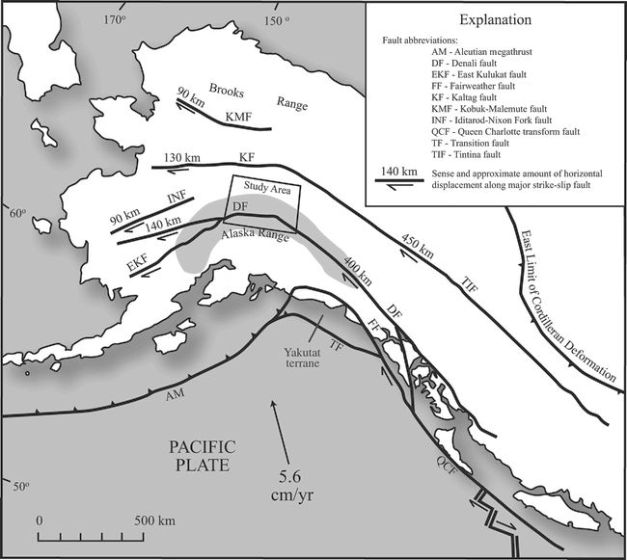
Magmas appear to be making their way to the surface via a series of major fault lines in western Alaska. Although none of the depictions I have found so far show the fault lines extending into the Bering Sea, I believe they extend well into the continental shelf area of the Bering. It is these lines of weakness that magmas have reached the surface, not unlike how they have done in the lines of weakness surrounding the Colorado Plateau or the Anatolian Plate in Turkey.
These faults include the Kaltag fault, Iditarod – Nixon fault, Denali Fault, and the East Kulukat fault. Displacement along all four fault lines are is generally westbound, adding to speculation that the entire block is being extruded to the west.

Wilderness birding on the KooKooligit Mountains, St. Lawrence Island, Alaska. https://www.wildernessbirding.com/photo-galleries-updated/
Conclusions
You would not think that such a remote region would have such a complex tectonic foundation. Yet western Alaska does. Better yet, it behaves a lot like the desert SW US – Arizona, New Mexico, Utah, with prolific intra-plate basalts. The region is still active, with recent lavas only a few millennia old. I would not bet against future eruptions in this region.
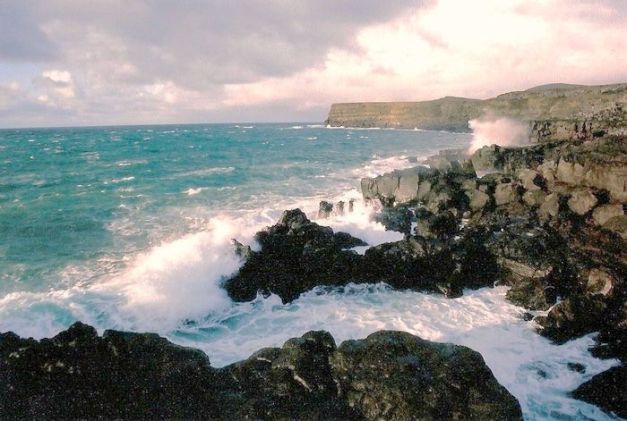
Pribilof islands lava flows into the sea. https://ultima0thule.blogspot.com/2014/08/st-paul-and-st-george-on-sub-arctic.html
Additional information
https://volcanocafe.wordpress.com/2014/10/12/seward-peninsula-volcanic-fields/
http://www.giseis.alaska.edu/input/carl/teaching/extra/wallace1.pdf
http://www.czech-in.org/cmdownload/IUGG2015/presentations/IUGG-4302.pdf
https://deepblue.lib.umich.edu/bitstream/handle/2027.42/95605/jgrb14956.pdf?sequence=1&isAllowed=y


Wow, now that’s interesting, that would explain some things. If I remember right, the Kuril-Kamchatka Trench used to be an active subduction zone far further to the NE, and I’ve always wondered why the part north of the triple junction has become inactive. At that time, the northern boundary of the Pacific plate must have been much further N as well, with that plate moving NW, or almost N, into Russia. Now, if the Bering block was squeezed out westward that might have halted any northern progress of the PA plate. So the PA plate began subducting more south, creating the AL trench and Islands. That way it stopped subducting at the northern part of the Ku-Ka Trench as well.
Looking at the sea ground features, this would also explain the last kink in the Emperor chain, which now turns NW for its last 400 km from going almost N before. Suppose it has gone north before, then what is now the Shirshov Ridge could have been its continuation north into northern Siberia… I just read that reseach has found the ends of the Shirshov R. to be of different ages but could not access the paper as sci-hub is down… Hope they get up again, otherwise, perhaps – DFM? (DOI: 10.1134%2FS000143700705013X)
LikeLike
Howdy Granyia –
Interesting. Hadn’t followed the thought trail that far.
I’m still trying to figure out what caused the scorpion’s tail in the Bering Sea north of Amchitka / Little Sitkin / Semisopochnoi / Kiska Islands. Stay warm. Cheers –
LikeLike
Earthquake yesterday close to the location of the 1964 quake. On the one hand, you do want things to keep moving in that part of the state. On the other, it sure does increase the pucker factor. Cheers –
https://www.adn.com/alaska-news/2017/11/27/magnitude-5-3-earthquake-hits-prince-william-sound/
LikeLike
Very puzzled by the lack of correlation between the bouts of tremor at Agung, which seem pretty periodic, and the lack of associated eruptive activity on the webcam. Given that the tremor is meant to be caused by bubble nucleation and/or magma wagging as it moves up through the system (which by definition happens at pretty shallow levels) I wonder where all the gas and magma is going. The two seem to contradict each other. Normally when a system is open and the magma contains little gas, then you don’t get such significant tremor, sometimes none at all, and you see a sustained effusive eruption of a lava field. But the tremor indicates there must be a good deal of gas involved, so you would expect a lot of fragmentation, more akin to Etna’s SE crater, yet we are not seeing that.
Nor are we seeing anything like Shinmoedake, where a sticky lava lake (or very runny lava dome – take your pick) trapped enough gas for large bubbles to form that then popped in dramatic vulcanian bursts. So the webcam indicates that either the system has low gas content (maybe because it is currently still pushing out old magma that has had time to degas), or it is degassing easily without any associated explosions (this implies that the gas bubbles don’t have time to coalesce before getting released – an indication of hot mafic gas lava with very low gas content), or that the volcano actually hasn’t really started erupting properly yet and the related gas is still contained in its system. Of these three, and looking at the 1964 eruption, I think the latter is the most likely scenario. The eruption might of course still stall and the volcano will go back to sleep, even in this scenario.
The other possibility is that the periodic tremor is caused by geothermal activity that (like a geyser) takes a few hours to reach a critical point before boiling off for an hour or so. Given the rains, this could also be the case and would explain the periodicity in the tremor.
LikeLike
Looking through comments elsewhere it appears the second scenario is the right one. The crater is filling with fresh lava that is obviously degassing in a non-explosive way, implying pretty hot/low crystalline/low gas (or any combination thereof) magma.
LikeLike
Albert’s piece on the 1963 eruption said that perhaps a month of lava flows, explosions, and some PFs preceded the major aerial and pyroclastic activity. Might still be on track for a reprise 54 years after the last one. Cheers –
LikeLike
Hi Agimarc, another great piece by the way. I love the way you try to puzzle out the tectonics behind these things. Your output is prodigious! wonderful stuff.
Re Agung, I agree that a reprise of 1963 is definitely on the cards. I was just wondering how the mechanics behind it all work. Ignoring the initial phreatic throat clearing, the lava getting extruded now must already be gas depleted or be so hot and low crystalline that it can degas in a non-explosive way. I don’t know which it is. One possibility is that as the magma cools (crystallises) it stops degassing so easily allowing bubbles to coalesce and finally explode in a bigger eruption. Another possibility is that this first batch of magma is “old” magma that is gas-depleted and once it is gone, gas-rich magma from the new intrusion gets erupted in a more explosive eruption. Or maybe it is some combination of both. The intensity of the tremor suggests there is a lot of bubble nucleation at shallow levels.. so where is all this gas going? I can’t quite get my head around it.
LikeLike
Howdy Bruce –
Thank you for the kind words.
Also trying to figure out how Agung works. We have a lot of pieces and a model (the 1963) eruption, though as far as I can tell nobody did an analysis of why that eruption proceeded as it did.
Pieces:
– Possible magma sheets (stacked dikes) in the conduit (from Unzen)
– Hot magma interacting with water in and / or near the top of the crater
– Phreatic eruption
– Lots of water in the form of local rains
– Lava in the crater
– Continuing tremor
I am thinking the shape of the magma intrusion up the conduit has a lot to do with what is going on. Don’t know how. Am also scratching my head about batching of magma in the system. If the magma is relatively viscous, we are not going to see a lot of mixing as the new intrusion mixes with the old. Rather you get the relatively shallow old stuff pushed up by the new like a plug or a cork or Pelee on Martinique. But that early stuff doesn’t present as a liquid. Problem is that at Unzen we saw that what was left after the last eruption cooled pretty quickly. Think that old stuff being pushed by new, hotter, more gas-laden new magma is a decent opening bid, but what happens after that? This would also suggest that the old magma is relatively gas depleted. Once the lid is off, the system opens up and we get a pretty intense eruption. Would submit that the system is not open yet.
Enough early Sunday arm-waving. Lots of food for thought from this one. Cheers –
LikeLike
looks like it is about to get interesting at Agung. Plot now showing distinct tornillos, despite the pathway being supposedly open and a rather flat lava dome now half-filling the crater.. looks like the explosive stuff is on the way to the surface like a rerun of the 1963 eruption. I guess it is all just a question of relative volumes at this stage as to whether it gets as big as 1963 again or fizzles out beforehand.
LikeLike
Hmm… I don’t see tornillos. I see lots of Volcano-Tectonic, some Spasmodic Tremor, background noise. Tornillos are not supposed to have such high-amplitude P-S-wave onsets as VTs have. Have you saved a sample? Below is what I see at the moment.
As to the explosive stuff: Do you not think that the 1963 explosive part was caused by the eruption of andesite following an initial flow of basalt?
LikeLike
You might be right.. I thought I saw a couple in there when I looked, long tailed numbers, like the small one dead center in your screen shot between the two larger quakes.
LikeLike
Maybe these are, in the lines ending at 14 and 14:30 UTC? Would be nice if someone knowledgeable could confirm or dismiss…
LikeLike
Would be great if they get the drone up there again soon.
LikeLike
I was surprised too reading yesterday’s report: “Satellite data also indicate that eruption of lava is ongoing within the summit crater. These data have recorded high temperatures consistent with new lava within the crater on 27, 28 and 29 November 2017. The volume of lava in the crater is currently about 20 million cubic meters, equivalent to about a third of the total crater volume.” That is quite lot of piling up in the crater. So perhaps, the high tremor periods are when lifting up the new, cooling layer of lava, which must be more than 100m high by now, but otherwise it is open system effusion. Yes, I am looking forward to new drone footage as well!
LikeLike
Now this might be groundbreaking work: new variation on the fundamental concepts of plate tectonics – why has the Central Anatolian Plateau (Turkey) risen for one kilometer in the past ten million years?
Article: Geophysicists uncover new evidence for an alternative style of plate tectonics
Paper: Drip tectonics and the enigmatic uplift of the Central Anatolian Plateau
LikeLike
oh wow, you guys do know I have to work sometime today right?
LikeLike
What is this work of which you speak? (tongue firmly in cheek) Cheers –
LikeLike
Just… ground-breaking :p
LikeLike
I got that cartoon sent by a friend when I debated the question whether to give in to the landlords and redecorate the flat on moving out – or to continue threatening them with the law. Guess what, I persevered and won! 🙂
LikeLike
There was a parody of Star Trek made 18 years ago called Galaxy Quest. Funny as Hell. One of the few flicks I watch every single time it is on. Their catch phrase was “Never give up. Never surrender.” So be it with you. Cheers –
LikeLiked by 1 person
Howdy Granyia –
Saw that last week. Thanks for bringing it forward. You know that same mechanism might also explain the uplift under the TransAntarctic Mountains. Cheers –
LikeLike
There we go again, the webcam is shaking badly but too many clouds to see anything…
LikeLike
New post is up! 🙂
LikeLike